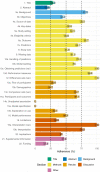Prediction models using artificial intelligence and longitudinal data from electronic health records: a systematic methodological review
- PMID: 37659105
- PMCID: PMC10654870
- DOI: 10.1093/jamia/ocad168
Prediction models using artificial intelligence and longitudinal data from electronic health records: a systematic methodological review
Abstract
Objective: To describe and appraise the use of artificial intelligence (AI) techniques that can cope with longitudinal data from electronic health records (EHRs) to predict health-related outcomes.
Methods: This review included studies in any language that: EHR was at least one of the data sources, collected longitudinal data, used an AI technique capable of handling longitudinal data, and predicted any health-related outcomes. We searched MEDLINE, Scopus, Web of Science, and IEEE Xplorer from inception to January 3, 2022. Information on the dataset, prediction task, data preprocessing, feature selection, method, validation, performance, and implementation was extracted and summarized using descriptive statistics. Risk of bias and completeness of reporting were assessed using a short form of PROBAST and TRIPOD, respectively.
Results: Eighty-one studies were included. Follow-up time and number of registers per patient varied greatly, and most predicted disease development or next event based on diagnoses and drug treatments. Architectures generally were based on Recurrent Neural Networks-like layers, though in recent years combining different layers or transformers has become more popular. About half of the included studies performed hyperparameter tuning and used attention mechanisms. Most performed a single train-test partition and could not correctly assess the variability of the model's performance. Reporting quality was poor, and a third of the studies were at high risk of bias.
Conclusions: AI models are increasingly using longitudinal data. However, the heterogeneity in reporting methodology and results, and the lack of public EHR datasets and code sharing, complicate the possibility of replication.
Registration: PROSPERO database (CRD42022331388).
Keywords: artificial intelligence; deep learning; electronic health records; longitudinal data; prediction; systematic review.
© The Author(s) 2023. Published by Oxford University Press on behalf of the American Medical Informatics Association.
Conflict of interest statement
None declared.
Figures



References
-
- Mintz Y, Brodie R.. Introduction to artificial intelligence in medicine. Minim Invasive Ther Allied Technol. 2019;28(2):73-81. - PubMed
-
- Buchlak QD, Esmaili N, Leveque J-C, et al. Machine learning applications to clinical decision support in neurosurgery: an artificial intelligence augmented systematic review. Neurosurg Rev. 2019;43(5):1235-1253. - PubMed
-
- James MT. Longitudinal studies 4: matching strategies to evaluate risk. In: Parfrey PS, Barrrett BK, eds. Clinical Epidemiology. Methods in Molecular Biology. Vol. 2249. Springer; 2021:167-177. - PubMed

